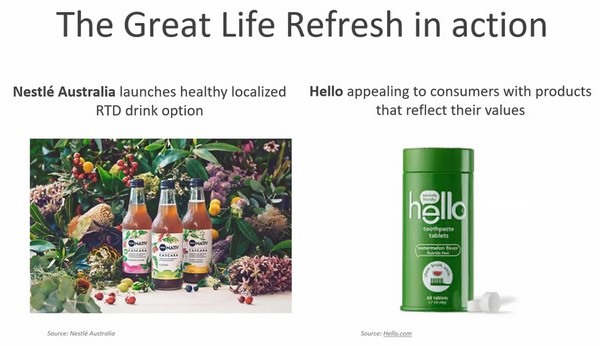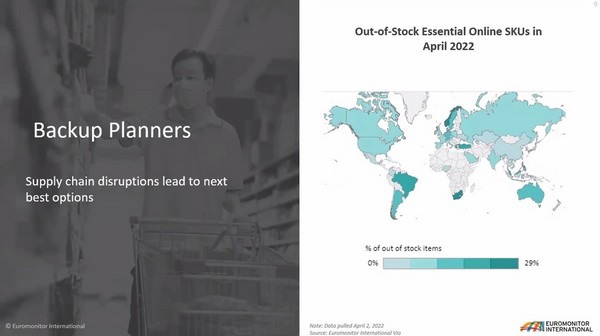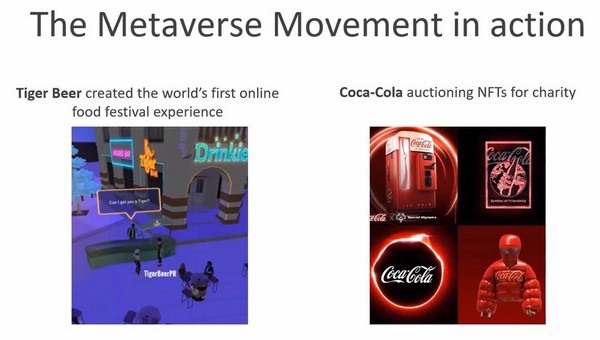“How are consumers' values and behaviors shifting? And what does this mean for business?”
These were some questions answered at yesterday’s IFPA Virtual Town Hall where Alison Angus, head of lifestyle for Euromonitor International, rounded up the “Top Ten Global Consumer Trends for 2022.”
“Last year, consumers were resilient and adaptable and altering habits. Now the world is on the road to recovery though with a lot of unknowns still,” she said. “But consumers are making some of these changes permanent. They are taking control and paving a path forward based on renewed passions and values.”
Here are the 10 trends Angus outlined and what they mean for businesses today.
1. The great life refresh: “People have had so much time to rethink during the pandemic and many made changes in their personal lives--new beliefs and new priorities have led them to move, take up new interests, make healthier choices,” said Angus.
And so emerged consumers with a greater appreciation for work-life balance, who are part of “The Great Resignation” and prioritizing health and happiness.
“For business it’s crucial to stay aware of what those changes are,” said Angus. “What changes are consumers making that are influencing their purchase decisions? Awareness of that means it’s important to innovate to ensure the goods and services being offered to consumers really respond to these changes.”
 Angus pointed to a recent initiative from NESCAFÉ NATIV Cascara in Australia, a drink made from up cycled coffee berries, was infused with Australian botanical flavors and was 99 percent produced in Australia. “They are innovating around healthier, non-alcoholic adult social beverages This addition of native ingredients and being manufactured within the country really taps into the growing trend towards localization,” said Angus.
Angus pointed to a recent initiative from NESCAFÉ NATIV Cascara in Australia, a drink made from up cycled coffee berries, was infused with Australian botanical flavors and was 99 percent produced in Australia. “They are innovating around healthier, non-alcoholic adult social beverages This addition of native ingredients and being manufactured within the country really taps into the growing trend towards localization,” said Angus.
2. The socialization paradox: “There are different feelings about resurfacing from the pandemic--some are raring to go and others are not comfortable with it at all,” said Angus. “It’s tough for business because target audiences could be at either end of the spectrum. They need to consider how to cater to groups of consumers at extremes and adapt to the many ways they’re living.”
This points to seamless hybrid business models and investing in digital solutions that sit beside traditional in-person solutions. “How and when and where are they socializing? We’re seeing new social occasions and that can impact food choices,” said Angus. Starbucks for example offers its products in a variety of ways to consumers--in retail outlets, via an app or website, curbside pickup, in-store shopping, drive through and dine in. “Consumers want to indulge in those new social occasions whether it’s at home or out of home.
Suppliers need to support retailers and hospitality in reaching both sets of consumers and providing a really strong customer experience wherever that may be. And they need to think about how to support all of this with relevant pack types, packaging and promotional materials and even the goods themselves,” said Angus.
3. Self-love seekers: “Consumers are embracing who they truly are. They are invested in taking care of themselves first and foremost--they’re prioritizing their own happiness first and foremost. They surround themselves with people and products that align with their true identities,” said Angus.
That means buying products that showcase and enhance their minds and bodies. In products, while the focus on immunity is slowing down as COVID becomes less of a focus, a new focus is emerging.
“Consumers will replace this by looking for longer-term emotional and mental wellness focus,” she said. “Companies should think about this trend and may want to rework formats and experiences to help consumers feel fulfilled, self-assured and enable them to be who they want to be.”
This very much includes single people--a population expected to overtake married people as the largest population group next year. “They’re getting more confident in going solo across all activities. There are rapidly growing opportunities for single consumers activities, gifting and treats,” said Angus.
4. Back up planners: Supply chain shortages continue to create challenges for consumers to get the products they want. “Back up planners are faced with this and with inflation and are being more creative in their purchases,” said Angus. “On one hand they’re looking for cost-effective alternatives to their usual products. They’re choosing alternative brands, private label and second-hand. Others who are more affluent are happy to pay a premium price to get what they want.”

Consumers are also exploring alternate routes to get the products they want--think subscription plans or going directly to manufacturers to source items. “This direct to consumer subscription model is seeing really strong growth. They’re bypassing the traditional intermediaries but often they also have the added benefit of providing more personalized solutions,” said Angus. Last year for instance, Frito-Lay launched a subscription snacking service promising discounts, free shipping and more and was introduced to help overcome the “empty shelf syndrome” seen in stores.
“For suppliers, it’s about ensuring the supplies of ingredients so that the customer can get the product the consumer wants,” said Angus. “For businesses, it’s investing in technology, automation, localizing, sourcing, increasing the number of supplies to secure supply and more.”
5. The digital senior: “Seniors are an expanding, wealthy group of consumers getting more comfortable with technology, especially technology that helps them in their everyday lives,” said Angus. “But they still need tech support from businesses. So businesses need to adapt and simplify their digital platforms to make them easy for digital seniors to use. They’ve got to be frictionless solutions, straightforward and ideally supported with real person communications. So someone they can talk to online. If products or services aren’t catering to them, they’ll go to competitors.”
6. Financial aficionados: “Consumers are getting much better at managing money. They are tracking their spending and increasingly confident about investing in stocks, shares and even cryptocurrency,” said Angus. “We’ve also got rising living costs so consumers are saving and investing less. This is fuelling their desire to ensure that these investments do well and they pay close attention to their everyday spending.”
Consumers financial literacy is also increasing, in part thanks to financial companies offering more educational resources. “That’s helping build consumer confidence. The availability of more money management apps and simple to use financial products is helping people grow their financial acumen,” said Angus. “This gives them a new-found financial freedom that businesses can capitalize on.”
She pointed to the UAE's soda firm International Beverage and Filling Industries (IBFI) launching an affordable, but premium, soda. “They saw they needed to help consumers buy better products with their money so this product has a more upmarket look, is made from natural ingredients and gives these financial aficionados an alternative to global imported brands,” said Angus.

7. Pursuit of pre-loved: Consumers want to live sustainably and affordability is also important. Both of these interests are driving the pre-loved trend and a growing second-hand shopping market for goods. Angus says according to its survey, in 2021, 50 percent of consumers were either buying or selling second-hand products.
Companies are embracing the circular economy by offering buy-back programs, reusable packaging alternatives and in the food industry, thinking about food waste and repurposing food.
Angus pointed to Baldor Specialty Foods’ SparCs program (SparCs is “scraps” spelled backwards). “It has identified various uses for leftover food products such as animal feed, composting or as ingredients for restaurants to use in soups and juices,” said Angus.
And to help meet that affordability piece, apps such as Too Good to Go allow users to buy leftover food from nearby restaurants for a discount.
7. Climate change: Undoubtedly climate change is influencing consumers today. “And climate changers are walking the talk,” said Angus. “They want to reduce their impact on the climate with their choices so they’re looking for low-carbon diets, energy efficient and sustainable products. They need more options.”
In turn, while businesses are taking steps to reduce their carbon footprints, they can help consumers make informed choices.
“Affordability is an obstacle. Consumers want these products and while some can pay a premium, for others it’s not achievable,” said Angus. “Businesses can help with being more transparent i.e. investing in digital product labelling, mobile tracking apps that allow consumers to understand more about the product’s ethical claims and carbon footprint.”
She added that narratives are as important as the product themselves. “You may be doing a lot to be more sustainable but do your customers know this?” For example, Walmart U.S.’s online store has begun adding icons to highlight products that reduce climate impact.
9. Rural urbanites: Consumers want better air quality, more green living spaces and have also had increased work location flexibility to help them access all of that.
“Work is getting less tied to a physical office so we’ll see more consumers thinking about suburb and rural locations as a permanent option,” says Angus. For businesses, this means new opportunities to reach consumers in these areas by scaling up distribution or looking for micro fulfillment centers to ensure strong last-mile delivery.
However not all rural urbanites want to leave the city. Some are coming back or staying put and want to bring the simplicity of rural life to their homes and neighborhoods. “There’s this need for more localized brick and mortar services serving these rural populations.
But there’s also thinking about how to support consumers in cities as well. There’s a need for more green spaces--indoor farming, rooftop farms, more shops and restaurants within local communities. The new “mini city” has everything within a 15 minute walk or cycle,” Angus said, says, pointing out that in Estonia, Membo is a virtual farmer’s market which allows consumers to live in either type of neighbourhood and have farm products delivered directly.

10. The Metaverse: People are already living in virtual spaces and embracing immersive digital worlds. “Businesses need to engage with consumers in these new spaces. Especially young people, who are spending a tremendous amount of time on video sharing, live streaming platforms TikTok, Twitch, Minecraft, Fortnite,” said Angus. (In turn, they’re also influencing the family members they live with about their Metaverse. “They’re enticing older generations to join them--or at least give them gift cards for purchasing in these spaces,” added Angus.)
For businesses, brands are entering the spaces by buying billboards and product placements or have virtual stores facilitating e-commerce sales. “You need to be thinking about the Metaverse now and building in strategy plans because that is where we are headed. It’s about changing the way you engage with consumers,” she said.
Even in food? Angus notes that the Tiger Beer Street Food Festival was the first food festival online experience which allowed users to interact with others, visit vendors, play games and win discounts and prizes…and IRL (in real life) order the street food from the experience online to get delivered to your door.
“Traditional business models and logistics networks are being challenged. Product availability is not a given and customer loyalty is not a given,” concluded Angus. “Consumers values and behaviors are shifting faster than ever. Businesses need to acknowledge it, embrace it and adapt to it.”
Photo: Dreamstime
